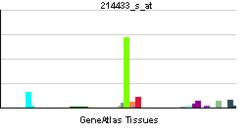SELENBP1
| Selenium binding protein 1 | |||||||||||||
|---|---|---|---|---|---|---|---|---|---|---|---|---|---|
| Identifiers | |||||||||||||
| Symbols | SELENBP1 ; HEL-S-134P; LPSB; SBP56; SP56; hSBP | ||||||||||||
| External IDs | OMIM: 604188 MGI: 96825 HomoloGene: 2930 GeneCards: SELENBP1 Gene | ||||||||||||
| |||||||||||||
| RNA expression pattern | |||||||||||||
 | |||||||||||||
| More reference expression data | |||||||||||||
| Orthologs | |||||||||||||
| Species | Human | Mouse | |||||||||||
| Entrez | 8991 | 20341 | |||||||||||
| Ensembl | ENSG00000143416 | ENSMUSG00000068874 | |||||||||||
| UniProt | Q13228 | P17563 | |||||||||||
| RefSeq (mRNA) | NM_001258288 | NM_009150 | |||||||||||
| RefSeq (protein) | NP_001245217 | NP_033176 | |||||||||||
| Location (UCSC) | Chr 1: 151.34 – 151.35 Mb | Chr 3: 94.93 – 94.94 Mb | |||||||||||
| PubMed search | |||||||||||||
Selenium-binding protein 1 is a protein that in humans is encoded by the SELENBP1 gene.[1][2]
This gene product belongs to the selenium-binding protein family. Selenium is an essential nutrient that exhibits potent anticarcinogenic properties, and deficiency of selenium may cause certain neurologic diseases. It has been proposed that the effects of selenium in preventing cancer and neurologic diseases may be mediated by selenium-binding proteins. The exact function of this gene is not known.[2]
Interactions
SELENBP1 has been shown to interact with USP33.[3]
References
- ↑ Chang PW, Tsui SK, Liew C, Lee CC, Waye MM, Fung KP (April 1997). "Isolation, characterization, and chromosomal mapping of a novel cDNA clone encoding human selenium binding protein". J Cell Biochem 64 (2): 217–24. doi:10.1002/(SICI)1097-4644(199702)64:2<217::AID-JCB5>3.0.CO;2-#. PMID 9027582.
- ↑ 2.0 2.1 "Entrez Gene: SELENBP1 selenium binding protein 1".
- ↑ Jeong, Jee-Yeong; Wang Yuxun; Sytkowski Arthur J (February 2009). "Human selenium binding protein-1 (hSP56) interacts with VDU1 in a selenium-dependent manner". Biochem. Biophys. Res. Commun. (United States) 379 (2): 583–8. doi:10.1016/j.bbrc.2008.12.110. PMID 19118533.
Further reading
- Kim H, Kang HJ, You KT et al. (2006). "Suppression of human selenium-binding protein 1 is a late event in colorectal carcinogenesis and is associated with poor survival.". Proteomics 6 (11): 3466–76. doi:10.1002/pmic.200500629. PMID 16645984.
- Huang KC, Park DC, Ng SK et al. (2006). "Selenium binding protein 1 in ovarian cancer.". Int. J. Cancer 118 (10): 2433–40. doi:10.1002/ijc.21671. PMID 16380993.
- Rual JF, Venkatesan K, Hao T et al. (2005). "Towards a proteome-scale map of the human protein-protein interaction network.". Nature 437 (7062): 1173–8. doi:10.1038/nature04209. PMID 16189514.
- Stelzl U, Worm U, Lalowski M et al. (2005). "A human protein-protein interaction network: a resource for annotating the proteome.". Cell 122 (6): 957–68. doi:10.1016/j.cell.2005.08.029. PMID 16169070.
- Miyaguchi K (2005). "Localization of selenium-binding protein at the tips of rapidly extending protrusions.". Histochem. Cell Biol. 121 (5): 371–6. doi:10.1007/s00418-004-0623-y. PMID 15108003.
- Ota T, Suzuki Y, Nishikawa T et al. (2004). "Complete sequencing and characterization of 21,243 full-length human cDNAs.". Nat. Genet. 36 (1): 40–5. doi:10.1038/ng1285. PMID 14702039.
- Strausberg RL, Feingold EA, Grouse LH et al. (2003). "Generation and initial analysis of more than 15,000 full-length human and mouse cDNA sequences.". Proc. Natl. Acad. Sci. U.S.A. 99 (26): 16899–903. doi:10.1073/pnas.242603899. PMC 139241. PMID 12477932.
- Porat A, Sagiv Y, Elazar Z (2000). "A 56-kDa selenium-binding protein participates in intra-Golgi protein transport.". J. Biol. Chem. 275 (19): 14457–65. doi:10.1074/jbc.275.19.14457. PMID 10799528.
- Lanfear J, Fleming J, Walker M, Harrison P (1993). "Different patterns of regulation of the genes encoding the closely related 56 kDa selenium- and acetaminophen-binding proteins in normal tissues and during carcinogenesis.". Carcinogenesis 14 (3): 335–40. doi:10.1093/carcin/14.3.335. PMID 8453708.
- Czar MJ, Owens-Grillo JK, Dittmar KD et al. (1994). "Characterization of the protein-protein interactions determining the heat shock protein (hsp90.hsp70.hsp56) heterocomplex.". J. Biol. Chem. 269 (15): 11155–61. PMID 8157642.
- Dawson SJ, White LA (1992). "Treatment of Haemophilus aphrophilus endocarditis with ciprofloxacin.". J. Infect. 24 (3): 317–20. doi:10.1016/S0163-4453(05)80037-4. PMID 1602151.
- Bartolone JB, Birge RB, Bulera SJ et al. (1992). "Purification, antibody production, and partial amino acid sequence of the 58-kDa acetaminophen-binding liver proteins.". Toxicol. Appl. Pharmacol. 113 (1): 19–29. doi:10.1016/0041-008X(92)90004-C. PMID 1553752.
- Veldscholte J, Berrevoets CA, Brinkmann AO et al. (1992). "Anti-androgens and the mutated androgen receptor of LNCaP cells: differential effects on binding affinity, heat-shock protein interaction, and transcription activation.". Biochemistry 31 (8): 2393–9. doi:10.1021/bi00123a026. PMID 1540595.